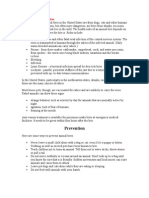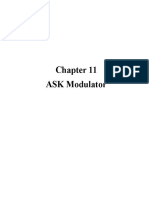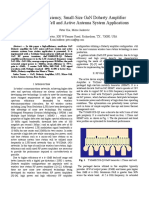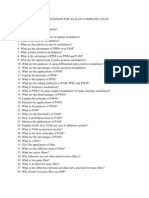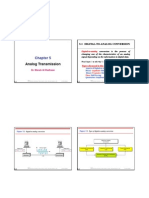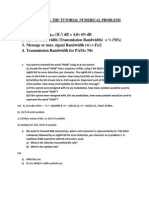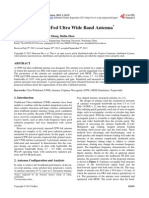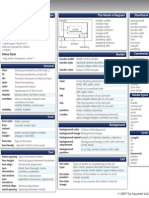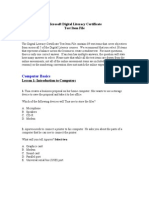Chap 5
Chap 5
Uploaded by
Ayman YounisCopyright:
Available Formats
Chap 5
Chap 5
Uploaded by
Ayman YounisOriginal Description:
Original Title
Copyright
Available Formats
Share this document
Did you find this document useful?
Is this content inappropriate?
Copyright:
Available Formats
Chap 5
Chap 5
Uploaded by
Ayman YounisCopyright:
Available Formats
Digital Communication (GTU)
5-1
Pulse Code Modulation
Chapter 5 : Pulse Code Modulation
Section 5.9 :
Ex. 5.9.4 :
A PCM system uses a uniform quantizer followed by a 7 bit encoder. The system bit rate
is 50 Mbits/sec. Calculate the maximum bandwidth of the message signal for which this
system operates satisfactorily.
.Page No. 5-26.
Soln. :
It has been given that : Bit rate r = 50 Mbits/sec and N = 7
We know that bit rate r = N fs
r
50 10
fs = N =
= 7.14 MHz
7
6
Maximum signal bandwidth BW = fs /2 =
7.14 MHz
2
BW = 3.57 MHz
Ex. 5.9.5 :
...Ans.
The bandwidth of a video signal is 4.5 MHz. This signal is to be transmitted using PCM
with the number of quantization levels Q = 1024. The sampling rate should be 20% higher
than the Nyquist rate. Calculate the system bit rate.
.Page No. 5-26.
Soln. :
Bandwidth W = 4.5 MHz
As per Nyquist rate fs = 2W = 9 MHz
But fs should be 20% higher than Nyquist rate
We know that,
Ex. 5.9.7 :
fs = 1.2 9 MHz = 10.8 MHz
Q =
2 ,
...(1)
1024 = 2
N = 10
System bit rate r = N fs = 10 10.8 MHz
Plot the characteristics of a -law compressor.
Soln. :
To plot the characteristics of -law compressor :
The expression for the normalized output of a -law compressor is given by,
ln (1 + | x | )
Z (x) =
..... x 1
ln (1 + )
Let
...(2)
= 255.
.Page No. 5-30
Digital Communication (GTU)
5-2
Pulse Code Modulation
Note that instead of |x| / xmax we have written only |x| and restricted the values of x only upto 1.
This has the same effect as that of normalizing.
ln (1 + 255 |x| )
Z (x) =
...(1)
ln 256
Substitute x = 0, 0.2, 0.4, 0.6, 0.8 and 1 in Equation (1) to get the corresponding values of Z as
shown in the following table.
|x|
0.2
0.4
0.6
0.8
0.71
0.84
0.9
0.96
Therefore the compressor characteristics is as shown in Fig. P. 5.9.7.
Fig. P. 5.9.7 : -law compressor characteristics
Section 5.15 :
Ex. 5.15.7 :
Soln. :
Given :
If a voice frequency signal is sampled at the rate of 32,000 samples/sec and
characterized by peak value of 2 Volts, determine the value of step size to avoid slope
overload. What is quantization noise power Nq and corresponding SNR ? Assume
bandwidth of signal as 4 kHz.
.Page No. 5-60.
fs = 32,000 samples/sec.
Peak value of the signal A = 2V.
Bandwidth B = 4 kHz.
1.
Step size to avoid slope overload :
To avoid slope overload the following condition should be satisfied.
A
fs
=
2 fm Ts 2 fm
Digital Communication (GTU)
5-3
Pulse Code Modulation
Substituting the values we get,
32000
3
2 4 10
3
2 2 4 10
32000
1.57 Volt
2.
Quantization noise power (Nq) :
...Ans.
The quantization noise power for a delta modulator is given by,
2
2
(1.57)
Nq =
=
3
3
Nq = 0.822 W
3.
...Ans.
Signal to noise ratio :
3
SNR =
Ex. 5.15.8 :
3 fs
8 fm B
2
3 (32 10 )
3 2
3 = 19.45
8 (4 10 ) 4 10
3 3
A compact disc (CD) records audio signals digitally by PCM. Assume audio signal's
bandwidth to be 15 kHz. If signals are sampled at a rate 20% above Nyquist rate for
practical reasons and the samples are quantised into 65,536 levels, determine bits/sec
required to encode the signal and minimum bandwidth required to transmit encoded
signal.
.Page No. 5-60
Soln. :
W = 15 kHz,
fs = 1.2 2 W = 2.4 15 kHz = 36 kHz,
Q = 65,536.
1.
Signaling rate (r) :
N
We know that Q = 2
N = log2 Q
log10 (65,536)
N =
= 16
log10 2
Signaling rate r = N fs = 16 36 kHz = 576 kbits/sec.
...(1)
...Ans.
Thus the signaling rate r is 576 kbits/sec.
2.
Minimum bandwidth :
1
BT = 2
576
Signaling rate = 2 kbits/sec
Minimum bandwidth BT = 288 kHz
Ex. 5.15.9 :
...Ans.
In a single integration DM scheme, the voice signal is sampled at a rate of 64 kHz. The
maximum signal amplitude is 1 Volt.
1.
Determine the minimum value of step size to avoid slope overload.
2.
Determine granular noise power N0, if the voice signal bandwidth is 3.5 kHz.
Digital Communication (GTU)
Assuming signal to be sinusoidal, calculate signal power So and signal to noise
ratio (SNR).
4.
Assuming that the voice signal amplitude is uniformly distributed in the range,
( 1, 1), determine So and SNR.
.Page No. 5-60
A = 1 Volt
Minimum step size to avoid slope overload :
fs
A
,
2 fm
min =
2.
Pulse Code Modulation
3.
Soln. :
Given : fs = 64 kHz
1.
5-4
2 fm A 2 3.5 103 1
=
= 0.3436 Volt
3
fs
64 10
Granular noise power :
2
fm (0.3436) 3.5
3
= 2.15 10 W
64
3 fs
3
2
Nq =
3.
...Ans.
...Ans.
Signal power So and SNRo :
As the signal is sinusoidal, the normalized output signal power
2
So = [A/ 2] = A/2 = 1/2 Watt.
So
0.5
SNRo =
=
= 232.3 or 23.66 dB.
Nq 2.15 10 3
4.
...Ans.
Signal power for uniformly distributed signal :
The signal PDF for a uniformly distributed signal is as shown in Fig. P. 5.15.9.
Fig. P. 5.15.9
1
Mean square value of the signal, E[S ] =
2
1
S fs (S) dS =
2
2
S dS =
1
1 3
[S / 3] 1 = 1/3
2
Assuming R = 1.
Normalized signal power So = Mean square value = 1/3 W
1/3 W
Signal to noise ratio = SNR =
= 155.03 or 21.9 dB
3
2.15 10 W
Ex. 5.15.10 :
...Ans.
...Ans.
The information in an analog signal voltage waveform is to be transmitted over a PCM
system with an accuracy of 0.1 % full scale accuracy. The analog voltage waveform has
a bandwidth of 100 Hz and an amplitude range of 10 to + 10 Volts.
(a)
Determine the minimum sampling rate required.
(b)
Determine the number of bits in each PCM word.
Digital Communication (GTU)
5-5
Pulse Code Modulation
(c)
Determine the minimum bit rate required in the PCM system.
(d)
Determine the minimum absolute channel bandwidth required for the transmission
of the PCM signal.
.Page No. 5-61
Soln. :
It has been given that,
1.
Accuracy of 0.1 % of full scale is expected.
2.
W = 100 Hz and amplitude range is 10 to + 10 V
(a)
Sampling rate fs :
By sampling theorem the minimum sampling rate is
fs (min) = 2W = 200 Hz
(b)
...Ans.
Number of bits per word (N) :
As accuracy is expected to be 0.1 % of full scale, the maximum quantization error should be
0.1 % of full scale.
max = 0.1 % of full scale
= 0.001 [10 ( 10)] = 0.001 20
max = 0.02 Volts
...(1)
We know that the maximum value of the quantization error is
max = S/2
...(2)
S/2 = 0.02
S = 0.04 Volt
...(3)
VH VL
But S =
Q
where
and
VH = 10 V
VL = 10 V
Q =
=
10 + 10
0.04
20
= 500
0.04
...(4)
But Q = 2
N log10 2 = log10 500
(c)
N = 8.96 9
...Ans.
System bit rate :
System bit rate (r) = N fs = 9 200 = 1800 bits/sec
...Ans.
Digital Communication (GTU)
(d)
5-6
Pulse Code Modulation
Transmission channel bandwidth (BT) :
BT
1
N fs
2
BT 900 Hz
Ex. 5.15.11 :
...Ans.
The information in an analog waveform with a maximum frequency fm = 3 kHz is to be
transmitted over an M level PCM system, where the number of pulse levels is M = 16.
The quantization distortion is specified not to exceed 1% of peak to peak analog signal.
1.
What is the maximum number of bits per sample that should be used in this
PCM system ?
2.
What is the minimum sampling rate and what is the resulting bit transmission rate ?
.Page No. 5-61
Soln. :
Given : fm = 3 kHz,
Number of quantization levels M = 16.
1.
Number of bits/sample (N) :
N
We know that, number of quantization levels M = 2 .
2.
= 16
N = 4
...Ans.
Minimum sampling rate :
fs (min) = 2 fm = 2 3 kHz
By sampling theorem :
3.
fs (min) = 6 kHz
...Ans.
Bit transmission rate :
r = N fs = 4 6 kHz
1.
Number of quantization levels, Q = 2 = 2 = 128
Ex. 5.15.12 :
Soln. :
Given :
r = 24 kbits/sec.
...Ans.
...Ans.
A TV signal with a bandwidth of 4.2 MHz is transmitted using binary PCM. The number of
quantization levels is 512. Calculate :
1.
Code word length
2.
Transmission bandwidth
3.
Final bit rate
4.
Output signal to quantization noise ratio.
.Page No. 5-61
fm = 4.2 MHz and Q = 512.
Code word length (N) :
N
Q = 2
log 512
N =
log 2
N = 9 bits/word
...Ans.
Digital Communication (GTU)
2.
5-7
Pulse Code Modulation
Transmission bandwidth :
BT =
1
1
N fs = N (2 fm)
2
2
BT = 9 4.2 MHz = 37.8 MHz
3.
...Ans.
Final bit rate (r) :
r = N fs = 9 2 fm = 18 4.2 MHz
r = 75.6 Mb/s
...Ans.
4.
Signal to quantization noise ratio :
Since the TV signal is not a sinusoidal signal, let us use the general expression of signal to
quantization noise ratio.
S = 4.8 + 6 N dB = 4.8 + (6 9)
Nq
S
= 58.8 dB
Nq
...Ans.
This is the maximum signal to noise ratio that we are expected to get from this system.
Ex. 5.15.13 :
The output signal to noise ratio (SNR) of a 10 bit PCM was found to be 30 dB. The
desired SNR is 42 dB. It was decided to increase the SNR to the desired value by
increasing the number of quantization levels. Find fractional increase in the transmission
bandwidth required for this SNR.
Soln. :
Given :
1.
.Page No. 5-61
SNR = 30 dB, N = 10
Desired value of SNR = 42 dB.
To find N for SNR = 42 dB
With increase in N by 1 bit the value of SNR increases by 6 dB. Therefore to increase the value
of SNR by 12 dB it is necessary to increase N by 2.
N = 10 + 2 = 12
2.
...Ans.
Fractional increase in BW :
BW of PCM system =
1
N fs
2
BW with N = 10 is given by, BW10 =
1
10 fs = 5 fs
2
and BW with N = 12 is given by, BW12=
1
12 fs = 6 fs
2
Change in BW = BW = 6 fs 5 fs = fs
Fractional change in BW =
fs
BW
=
100 % = 20 %
BW10 5 fs
...Ans.
Digital Communication (GTU)
Ex. 5.15.14 :
5-8
Pulse Code Modulation
A telephone signal with cut-off frequency of 4 kHz is digitised into 8 bit PCM, sampled at
Nyquist rate. Calculate the baseband transmission bandwidth and quantization S/N ratio.
.Page No. 5-61
Soln. :
1.
The Nyquist rate
2.
Transmission bandwidth, BT
3.
SNRq
Ex. 5.15.15 :
= 2 4 kHz = 8 kHz.
=
1
1
N fs = 8 8 kHz = 32 kHz
2
2
...Ans.
= (1.8 + 6N) dB = 1.8 + (6 8) = 49.8 dB
...Ans.
In a single integration DM scheme the voice signal is sampled at a rate of 64 kHz. The
maximum signal amplitude is 2 Volts. Voice signal bandwidth is 3.5 kHz. Determine the
minimum value of step size to avoid slope overload and granular noise power.
.Page No. 5-61
Soln. :
Given :
1.
fs = 64 kHz,
Amax = 2V,
fm = 3.5 kHz
Minimum step size to avoid slope overload :
We know that
Amax =
2.
min =
min fs
2 fm
2 fm Amax 2 3.5 103 2
=
= 0.6872 Volt
3
fs
64 10
...Ans.
Granular noise power :
Nq =
Ex. 5.15.16 :
2
2
fm (0.6872) 3.5
3
=
= 8.6 10 W
64
3 fs
3
...Ans.
A television signal (video and audio) has a bandwidth of 4.5 MHz. This signal is sampled,
quantized and binary coded to obtain a PCM signal.
1.
Determine the sampling rate if the signal is to be sampled at a rate 20% above the
2.
If the samples are quantized into 1024 levels, determine the number of binary pulses
3.
Determine the binary pulse rate (bits per second) of binary coded signal and the
Nyquist rate.
required to encode each sample.
minimum bandwidth required to transmit the signal.
If above linear PCM system is converted to companded PCM, will the output bit rate
changed ? Justify.
.Page No. 5-62
Digital Communication (GTU)
5-9
Pulse Code Modulation
Soln. :
Given :
W = 4.5 MHz
Sampling rate = 1.2 Nyquist rate = 1.2 2 W
1.
= 1.2 2 4.5 10 = 10.8 MHz
6
2.
...Ans.
Given that number of quantization levels, Q = 1024
But Q = 2
Number of binary pulse per word, N = log2 Q
N = log2 1024
N = 10
Bandwidth =
Ex. 5.15.17 :
...Ans.
Binary pulse rate (bit rate) = N fs = 10 10.8 MHz = 108 Mbps
3.
...Ans.
1
bit rate = 54 MHz
2
...Ans.
A compact disc (CD) records audio signals digitally by using PCM. Assume the audio
signal bandwidth to be 15 kHz.
1.
What is Nyquist rate ?
2.
If the Nyquist samples are quantized into L = 65,536 levels and then binary
coded,determine the number of binary digits required to encode a sample.
3.
Determine the number of binary digits per second (bit/s) required to encode
the audio signal.
4.
For practical reasons, the signals are sampled at a rate well above Nyquist rate
at 44,100 samples per second. If L = 65,536, determine number of bits per second
required to encode the signal and transmission bandwidth of encoded signal.
.Page No. 5-62.
Soln. :
Given :
W = 15 kHz
1.
Nyquist rate = 2 W = 2 15 kHz = 30 kHz.
...Ans.
2.
Number of quantization levels Q = 65,536
N
we know that Q = 2
N
2 = 65,536
N = 16 bits.
...Ans.
Number of bits to encode each sample is N = 16.
3.
Number of bits per second
= Number of samples/sec. Number of bits/sample
3
...Ans.
= 15 10 16 = 240 k bits/sec.
4.
Practical sampling rate fs = 44.1 kHz
Number of bits per second = 44.1 16 10 = 705.6k bits/sec.
3
Bit rate 705.6 10
Transmission bandwidth B =
=
= 352.8 kHz.
2
2
3
...Ans.
Digital Communication (GTU)
Ex. 5.15.18 :
5-10
Pulse Code Modulation
A Delta Modulator system operates at 3 times Nyquist rate for signal with 3.3 kHz
bandwidth. The quantisation step is 250 mV. Determine the maximum amplitude of a 1
kHz input sinusoid for which the DM does not show slope overload.
Soln. :
Given :
1.
.Page No. 5-62.
W = 3.3 kHz, fm = 1 kHz, = 250 mV, fs = 3 2W = 19.8 kHz.
Let the maximum amplitude of 1 kHz input sinusoid be A.
The condition to avoid the slope overload is
A
m Ts
Maximum value of A =
fs
=
m Ts 2 fm
Substituting the values we get,
250 10 19.8 10
2 1 103
3
Amax =
Amax = 0.787
Ex. 5.15.19 :
An audio signal with highest frequency component 3300 Hz is pulse code modulated with
a sampling rate of 8000 samples/sec. The required signal-to-quantisation noise ratio is
40 dB.
1.
What is the minimum number of uniform quantising levels needed ?
2.
What is the minimum number of bits per sample needed ?
3.
Calculate the minimum number of bits per sample needed ?
.Page No. 5-62.
Soln. :
Given : fs = 8000 samples/sec. , fm = 3300 Hz.
1.
S
Nq = 40 dB
To calculate Q and N :
Assuming the input signal to be non sinusoidal we write
S/N = (4.8 + 6 N) dB
40 = 4.8 + 6N
N = 5.86 6
Thus the number of bits per word is 6.
N
6
Q = 2 = 2 = 64
Thus the number of quantization level is 64.
2.
...Ans.
...Ans.
The signaling rate (r) :
r = N fs = 6 8 10 = 48 kbits/sec.
3
3.
Transmission bandwidth :
Minimum BW,
BT =
1
r = 24 kHz.
2
Digital Communication (GTU)
Ex. 5.15.20 :
5-11
Pulse Code Modulation
Delta modulator (DM) gives output pulses + p (t) of p (t). The output of DM is + p (t)
when instantaneous sample is larger than previous sample value and is p(t) when
instantaneous sample is smaller than previous sample value (last sample). The p(t) has
2 microsecond duration and 628 mV amplitude and repeats every 10 microsecond. Plot
the input and output of DM on graph paper one below other to same scale if the input to
DM is 1 Volt sine wave of frequency 10 kHz for one cycle of input wave. What is the
maximum frequency with 1 Volt amplitude that can be used in this system without slope
overload distortion.
.Page No. 5-62.
Soln.
Part I : To plot the DM signal
The D. M. Signal is as shown in Fig. P. 5.15.20.
Fig. P. 5.15.20 : DM signal
Part II : Maximum frequency :
Given :
A = 1V, fm = 10 kHz,
fs = 1/Ts = 1/10 s = 100 kHz. = 265 mV.
The condition for avoiding the slope overload is
A >
m Ts
Digital Communication (GTU)
5-12
Pulse Code Modulation
256 10
6
m 10 10
3
1 =
n = 25.6 10 rad /sec.
3
fmax = 4074.36 Hz
...Ans.
This is the maximum input frequency without introducing any slope overload distortion.
You might also like
- TM600 XDSL TesterDocument50 pagesTM600 XDSL TesterMouseBot Games0% (1)
- Lesson 7 Quick Study With AnswersDocument4 pagesLesson 7 Quick Study With AnswersSissel GoingNo ratings yet
- Cliffs TOEFL Preparation GuideDocument674 pagesCliffs TOEFL Preparation GuideNguyen Phuc Pham94% (16)
- Unit Ii Telemedical Technology 9: Multimedia-Text, Audio, Video, DataDocument48 pagesUnit Ii Telemedical Technology 9: Multimedia-Text, Audio, Video, DataSumathy Jayaram83% (6)
- Topic 3 - Source CodingDocument65 pagesTopic 3 - Source CodingMarlon BoucaudNo ratings yet
- Pulse Code Modulation (PCM)Document19 pagesPulse Code Modulation (PCM)Partha Pratim DasNo ratings yet
- Delta Modulation: EE 442 - Spring 2017Document12 pagesDelta Modulation: EE 442 - Spring 2017pushpeshNo ratings yet
- Exercise Chap 2Document3 pagesExercise Chap 2chantinh_hd190No ratings yet
- Chapter 06 - Basics of Digital AudioDocument97 pagesChapter 06 - Basics of Digital Audioa_setiajiNo ratings yet
- Gnuradio Tutorial 3Document9 pagesGnuradio Tutorial 3Tuan Do TrongNo ratings yet
- Hand Written Notes-DCDocument51 pagesHand Written Notes-DCAbhijeet KumarNo ratings yet
- EC6303 Signals and Systems Two Marks For Ece 2013 - 2013 - RegulationDocument15 pagesEC6303 Signals and Systems Two Marks For Ece 2013 - 2013 - RegulationSankar KumarNo ratings yet
- Application of Phase ModulationDocument5 pagesApplication of Phase Modulationdiwaker80% (5)
- Implementation of OFDM Systems Using GNU Radio and USRPDocument117 pagesImplementation of OFDM Systems Using GNU Radio and USRPSourourKanzariNo ratings yet
- Amplitude Modulation Part 1Document26 pagesAmplitude Modulation Part 1rwezioo100% (4)
- Basic of PCMDocument15 pagesBasic of PCMPablo TrujilloNo ratings yet
- Adf4350 Breakout SCHDocument1 pageAdf4350 Breakout SCHhackmanNo ratings yet
- Gnu RadioDocument19 pagesGnu RadioseesharpaNo ratings yet
- Frequency (FM) and Phase (PM) ModulationsDocument24 pagesFrequency (FM) and Phase (PM) Modulationsapi-370975260% (5)
- Machines 1 PDFDocument112 pagesMachines 1 PDFK.K VIGNESHWARNo ratings yet
- System Control Secret CodeDocument1 pageSystem Control Secret Codemudassir2640No ratings yet
- Microphone Calibration by Transfer Function Comparison MethodDocument5 pagesMicrophone Calibration by Transfer Function Comparison MethodJulian A. TinaoNo ratings yet
- 50 TOP MOST Electromagnetic Induction - Electrical Engineering Multiple Choice Questions and Answers Electrical Engineering Multiple Choice Questions PDFDocument15 pages50 TOP MOST Electromagnetic Induction - Electrical Engineering Multiple Choice Questions and Answers Electrical Engineering Multiple Choice Questions PDFSIVAKAMINo ratings yet
- Generating and Renewing An APNs Certificate For AirWatchDocument10 pagesGenerating and Renewing An APNs Certificate For AirWatchDigitriXNo ratings yet
- JAYSON - First AidDocument28 pagesJAYSON - First Aidapi-3757116No ratings yet
- 08 HirtenfelderDocument42 pages08 HirtenfelderMazigh HoudNo ratings yet
- Lte Random Access ProcedureDocument5 pagesLte Random Access ProcedureVarun VermaNo ratings yet
- ECT305 M3 Ktunotes - inDocument73 pagesECT305 M3 Ktunotes - inAthul SNo ratings yet
- Modul ASK Mod - DemodDocument45 pagesModul ASK Mod - DemodfarrasNo ratings yet
- Frequency Modulation Lecture NotesDocument8 pagesFrequency Modulation Lecture NotesKaushik Patnaik100% (1)
- Module 1 Part 2: Input/Output OrganizationDocument50 pagesModule 1 Part 2: Input/Output Organizations8102003No ratings yet
- Aplicación de Tecnologías de Medición Avanzada (AMI) Como Instrumento para Reducción de PérdidasDocument12 pagesAplicación de Tecnologías de Medición Avanzada (AMI) Como Instrumento para Reducción de PérdidasaRNULFO GUEVARANo ratings yet
- GaN Doherty Amplifier For LTE Micro Cell and Active Antenna System ApplicationsDocument4 pagesGaN Doherty Amplifier For LTE Micro Cell and Active Antenna System ApplicationsStephen MeyerNo ratings yet
- Design Engineering Project Direct Digital SynthesizerDocument41 pagesDesign Engineering Project Direct Digital SynthesizerManish AbrahamNo ratings yet
- Digital Satellite CommunicationsDocument154 pagesDigital Satellite CommunicationsEmmanuel Mupinga100% (2)
- The Cellular Concept - System Design FundamentalsDocument31 pagesThe Cellular Concept - System Design FundamentalsashaheerNo ratings yet
- Book Review of Communication System by Roy BlakeDocument57 pagesBook Review of Communication System by Roy BlakeDanny OxinaNo ratings yet
- CST Magic Tee Workflow1Document19 pagesCST Magic Tee Workflow1trsureshNo ratings yet
- Automatic Meter Reading PDFDocument8 pagesAutomatic Meter Reading PDFpraveen_kodgirwarNo ratings yet
- Radio Configuration ReferenceDocument22 pagesRadio Configuration Referencen2hj2n100% (1)
- The Network Layer: Andrew S. Tanenbaum Computer Networks Fourth Edition PP. 343-396Document82 pagesThe Network Layer: Andrew S. Tanenbaum Computer Networks Fourth Edition PP. 343-396Ss ShetNo ratings yet
- EE 370, Lecture 07Document5 pagesEE 370, Lecture 07Peshal NayakNo ratings yet
- Digital Signal Processing Lab ManualDocument171 pagesDigital Signal Processing Lab ManualRaj Kumar ChowdaryNo ratings yet
- Low Noise AmpDocument10 pagesLow Noise AmprajarpitNo ratings yet
- Analog Communication Viva QuestionsDocument3 pagesAnalog Communication Viva QuestionsMohammed RiyazuddinNo ratings yet
- Physical LayerDocument68 pagesPhysical Layerhari423No ratings yet
- Satellite CommunicationDocument50 pagesSatellite CommunicationSerj AlcantaraNo ratings yet
- 07 Chapter2Document13 pages07 Chapter2Arslan AliNo ratings yet
- Lab Report: Amplitude ModulationDocument6 pagesLab Report: Amplitude ModulationAsith SavindaNo ratings yet
- Propagation BasicsDocument76 pagesPropagation Basicsapi-3741610100% (3)
- Least Squares Quantization in PCMDocument9 pagesLeast Squares Quantization in PCMKoundinya ChunduruNo ratings yet
- Matlab 8Document12 pagesMatlab 8M Azeem100% (1)
- Tellegen's Theorem: Basic Electrical Engineering ProjectDocument13 pagesTellegen's Theorem: Basic Electrical Engineering Projectbrock lesnarNo ratings yet
- Phase ModulationDocument20 pagesPhase ModulationMuhammad Salah ElgaboNo ratings yet
- Digital To Analog ConversionDocument12 pagesDigital To Analog ConversionMukti SharmaNo ratings yet
- Patch Antenna PresentationDocument51 pagesPatch Antenna PresentationMoin KhalidNo ratings yet
- Optical and Microwave Technologies for Telecommunication NetworksFrom EverandOptical and Microwave Technologies for Telecommunication NetworksNo ratings yet
- Chhhpppttteeerrr 55555Document12 pagesChhhpppttteeerrr 55555S Ahson ASNo ratings yet
- Chap 5 120722024550 Phpapp02Document12 pagesChap 5 120722024550 Phpapp02Jowi Vega0% (1)
- Waveform Coding QuestionsDocument12 pagesWaveform Coding QuestionspadNo ratings yet
- Ex. 5.15.18: A Delta Modulator System Operates at 3 Times Nyquist Rate For Signal With 3.3 KHZ .Document3 pagesEx. 5.15.18: A Delta Modulator System Operates at 3 Times Nyquist Rate For Signal With 3.3 KHZ .S Ahson ASNo ratings yet
- DCS SolnDocument6 pagesDCS SolnSandeep Kumar100% (1)
- Wireless Communications Technologies: M of The First Kind, J Z)Document1 pageWireless Communications Technologies: M of The First Kind, J Z)Ayman YounisNo ratings yet
- Installation of WiMAXDocument24 pagesInstallation of WiMAXAyman YounisNo ratings yet
- Designing Mixed Structure Specified Controllers Using Particle Swarm Optimization (PSO) AlgorithmDocument6 pagesDesigning Mixed Structure Specified Controllers Using Particle Swarm Optimization (PSO) AlgorithmAyman YounisNo ratings yet
- Passive RFID For Object and Use Detection During Trauma ResuscitationDocument14 pagesPassive RFID For Object and Use Detection During Trauma ResuscitationAyman YounisNo ratings yet
- Chapter 3: Information Theory: Section 3.5Document23 pagesChapter 3: Information Theory: Section 3.5Ayman Younis100% (1)
- GRE Argument EssayDocument2 pagesGRE Argument EssayAyman YounisNo ratings yet
- Chapter 3: Information Theory: Section 3.5Document23 pagesChapter 3: Information Theory: Section 3.5Ayman Younis100% (1)
- Antenna IQ TestDocument0 pagesAntenna IQ TestAyman YounisNo ratings yet
- Synopsis:: Introduction To Practical AntennasDocument0 pagesSynopsis:: Introduction To Practical AntennasAyman YounisNo ratings yet
- EE370 Lab Experiment 01Document6 pagesEE370 Lab Experiment 01Ayman YounisNo ratings yet
- Design of A CPW-Fed Ultra Wide Band Antenna: Shaowen Hu, Yiqiang Wu, Ye Zhang, Huilin ZhouDocument5 pagesDesign of A CPW-Fed Ultra Wide Band Antenna: Shaowen Hu, Yiqiang Wu, Ye Zhang, Huilin ZhouAyman YounisNo ratings yet
- Camara Especial TVC TCFS749HDocument1 pageCamara Especial TVC TCFS749HTecnoSmartNo ratings yet
- RTN 950A V100R011C10 Product Description 02 PDFDocument342 pagesRTN 950A V100R011C10 Product Description 02 PDFAriel Pavez Cifuentes100% (1)
- HP Pagewide 477dwDocument2 pagesHP Pagewide 477dwRaya CreativeNo ratings yet
- Xerox 8830 PDFDocument2 pagesXerox 8830 PDFИвайло КолевNo ratings yet
- Difference Between TCP and UDP PDFDocument8 pagesDifference Between TCP and UDP PDFosama425No ratings yet
- CSS Help SheetDocument1 pageCSS Help Sheetkangax100% (18)
- Canon IR ADV C33xxDocument8 pagesCanon IR ADV C33xxAnonymous WD109UakyNo ratings yet
- Ultrawide Band (Uwb) Architecture PreviewDocument22 pagesUltrawide Band (Uwb) Architecture PreviewminisurabhiNo ratings yet
- MH 31a8j Technical Supplement PDFDocument1 pageMH 31a8j Technical Supplement PDFVitaliy OnyshchenkoNo ratings yet
- Yamaha WSG Y16 ManualDocument22 pagesYamaha WSG Y16 ManualNils Van der PlanckenNo ratings yet
- InterM 2010 AUDIO CatalogueDocument111 pagesInterM 2010 AUDIO CatalogueRadio PartsNo ratings yet
- Digital Multiplexing: Interleaving) As Shown in Fig 7.33a. or Word by Word Basis (KnownDocument7 pagesDigital Multiplexing: Interleaving) As Shown in Fig 7.33a. or Word by Word Basis (KnownselnemaisNo ratings yet
- Philips StressVue Stress Testing SystemDocument2 pagesPhilips StressVue Stress Testing SystemkasfikaNo ratings yet
- Product SpecificationDocument16 pagesProduct SpecificationRiza VirsadaNo ratings yet
- Cert Digital LiteracyDocument25 pagesCert Digital LiteracyMuhammad AsyrafNo ratings yet
- Toshiba 32W2433 DG ManualDocument69 pagesToshiba 32W2433 DG Manualnickd6776No ratings yet
- The NGN Carrier Ethernet SystemDocument52 pagesThe NGN Carrier Ethernet SystemjuharieNo ratings yet
- Introduction To LAN ProtocolsDocument20 pagesIntroduction To LAN Protocolsapi-26989621100% (2)
- Samsung MM-C330 C330DDocument6 pagesSamsung MM-C330 C330Dale_dimmservicios100% (1)
- IMS Why Use This New Thing? Give Me A Reason FirstDocument3 pagesIMS Why Use This New Thing? Give Me A Reason FirstAlessandro PazNo ratings yet
- Practices and Procedures For Setting Up Asterisk BootcampDocument12 pagesPractices and Procedures For Setting Up Asterisk BootcamptelephonicaNo ratings yet
- Basic Operation Guide: - For Use Without A ComputerDocument108 pagesBasic Operation Guide: - For Use Without A ComputerJefry MarkusNo ratings yet
- Wellav DMP900 & SMP100 Media PlatformDocument4 pagesWellav DMP900 & SMP100 Media PlatformVíctor MayaNo ratings yet
- bvp-900 950 900p 950pDocument140 pagesbvp-900 950 900p 950pRenzo SattiNo ratings yet
- DAP-2330 A1 Datasheet 01 (HQ)Document4 pagesDAP-2330 A1 Datasheet 01 (HQ)Sameer IbraimoNo ratings yet
- An Introduction To Log ShootingDocument10 pagesAn Introduction To Log ShootingSorin GociuNo ratings yet
- Network Blu-Ray Disc Player: Owner's Manual Model: BD370Document56 pagesNetwork Blu-Ray Disc Player: Owner's Manual Model: BD370Christos KarasteriouNo ratings yet
- FN-M16P Embedded MP3 Audio Module DatasheetDocument22 pagesFN-M16P Embedded MP3 Audio Module DatasheetEdgardo GambandeNo ratings yet
























